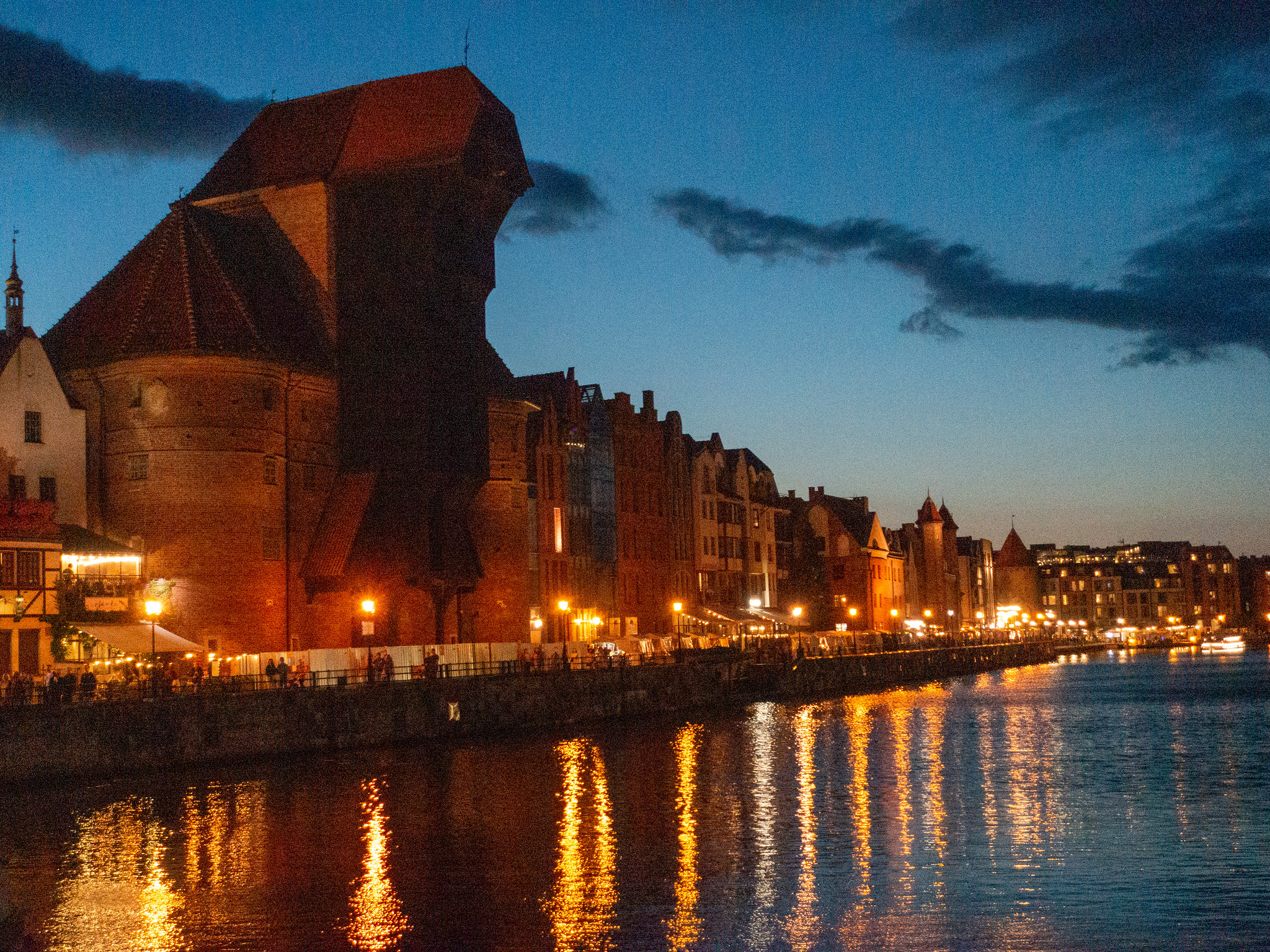The Gdansk Crane, also known as Żuraw in Polish, is an iconic medieval port crane located in Gdansk, Poland. Built in the mid-15th century, it stands as one of the most recognizable symbols of the city and a testament to its rich maritime history. The crane was used to load and unload cargo from ships and to place masts on vessels. It is the largest crane of its kind from medieval Europe, reaching a height of over 27 meters (89 feet). The wooden structure, supported by a brick base, features a unique double-treadwheel system that allowed it to lift heavy loads. Today, the Gdansk Crane serves as a branch of the National Maritime Museum, offering visitors a glimpse into the city’s past as a major Baltic seaport and center of trade.
Standing tall on the banks of the Motlawa River, the Gdansk Crane is an iconic landmark that has captured the imagination of visitors for centuries. This medieval wooden structure, with its distinctive silhouette, serves as a testament to the rich maritime heritage of Gdansk, Poland’s principal seaport and one of the oldest cities in the country.
Dating back to the 14th century, the Gdansk Crane was once the largest port crane in medieval Europe. Its primary function was to load and unload cargo from ships, as well as to place masts on sailing vessels. The crane’s impressive lifting capacity of up to 4 tons made it an indispensable tool for the bustling port, which was a key player in the Hanseatic League, a powerful merchant confederation that dominated trade in Northern Europe during the Late Middle Ages.
The crane’s unique design features two large wooden wheels, each measuring 6 meters in diameter. These wheels were powered by human operators who would walk inside them, much like hamsters in a wheel, to raise and lower heavy loads. This ingenious system allowed for the efficient handling of goods, contributing significantly to Gdansk’s prosperity as a major trading hub.
Over the centuries, the Gdansk Crane has weathered numerous storms, both literal and figurative. It has survived wars, fires, and the ravages of time, standing as a symbol of resilience and endurance. During World War II, the crane suffered extensive damage but was painstakingly reconstructed in the post-war years, a testament to its importance in the city’s cultural identity.
Today, the Gdansk Crane serves a different purpose, having been transformed into a branch of the National Maritime Museum. Visitors can explore the interior of this historic structure, gaining insight into its mechanical workings and the daily lives of the medieval crane operators. The museum offers a fascinating glimpse into Gdansk’s maritime past, showcasing artifacts and exhibits that bring the city’s seafaring history to life.
As you approach the crane, you can’t help but be struck by its imposing presence. The weathered wooden beams and intricate pulley systems speak to a bygone era of craftsmanship and engineering ingenuity. It’s easy to imagine the hustle and bustle of the medieval port, with ships from far-flung lands docking at the quayside, their holds brimming with exotic goods from distant shores.
The Gdansk Crane’s significance extends beyond its historical value. It has become a beloved symbol of the city, featured prominently in postcards, souvenirs, and local artwork. Its silhouette is instantly recognizable, evoking a sense of pride among Gdansk’s residents and serving as a tangible link to their maritime heritage.
For tourists, the crane is a must-see attraction, offering not only a glimpse into the past but also stunning views of the Motlawa River and the colorful facades of the buildings lining the waterfront. As the sun sets, the crane takes on an almost magical quality, its wooden frame silhouetted against the evening sky, a romantic reminder of Gdansk’s enduring charm.
In a world of rapid technological advancement, the Gdansk Crane stands as a poignant reminder of the ingenuity and skill of our ancestors. It continues to captivate visitors from around the globe, inviting them to step back in time and experience the rich tapestry of Gdansk’s maritime history. As both a functional relic of the past and a cherished cultural icon, the Gdansk Crane remains an enduring symbol of the city’s proud seafaring tradition, bridging the gap between medieval innovation and modern-day appreciation.
The Gdansk Crane, a historic landmark in Poland, stands as a testament to the city’s rich maritime heritage and economic importance during the medieval period. This iconic wooden structure, built in the 15th century, served as a crucial component of Gdansk’s bustling port, facilitating the loading and unloading of cargo ships. Despite suffering damage during World War II, the crane was meticulously restored and now functions as a museum, attracting visitors from around the world. Its enduring presence symbolizes Gdansk’s resilience and serves as a tangible link to the city’s prosperous past as a major trading hub in the Baltic region. The Gdansk Crane remains an essential part of the city’s cultural identity and a significant draw for tourists interested in maritime history and architecture.

